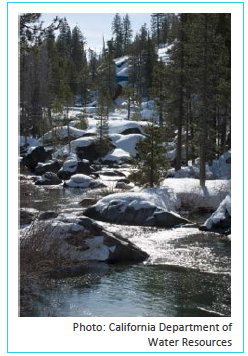
Snowmelt runoff
The fraction of runoff into the Sacramento River between April and July has declined over the past century.
The fraction of runoff into the Sacramento River between April and July has declined over the past century.
When air temperatures begin to warm in the spring, snow that has accumulated over the winter in California’s Sierra Nevada melts, releasing water as runoff. This runoff provides about one-third of the state’s annual supply for agriculture and urban needs. Over the past century, a greater proportion of runoff from the Sierra Nevada has been flowing into the Sacramento River earlier in the spring.
The volume and timing of snowmelt runoff are affected by air temperature. During the winter, warmer temperatures mean that less precipitation falls as snow than as rain, resulting in less snowpack. The earlier arrival of warmer temperatures in the spring causes snow to melt earlier in the year.
What does the indicator show?
Since 1906, the fraction of annual snowmelt runoff that flows into the Sacramento River between April and July (“spring”) has decreased by about nine percent. (The total volume of runoff each year has not changed, just its timing.) The graph below shows this spring fraction as the percentage of total runoff for the entire water year, which is the period from October through the following September. This decreased runoff was especially evident after 1950. The 2015 water year had the third lowest percentage of spring runoff on record (the lowest snowpack on record also occurred in 2015).
The shift in the timing of runoff is illustrated in the graph to the right. Compared to the 50-year period between 1906 and 1955 (red line), peak monthly runoff (when runoff volume is at its maximum) occurred nearly a month earlier in 1956 – 2007 (blue line). This shift indicates an earlier onset of springtime temperatures.
Why is this indicator important?
Spring runoff supplies Californians with water for domestic and agricultural uses, hydroelectric power generation, and recreation. Reduced runoff affects ecosystems, stressing vegetation and habitats for certain fish. Increased tree deaths and wildfires have also been linked to declining snowmelt. Tracking trends in spring snowmelt runoff is critical to understanding how runoff is affected by a changing climate.
For more information about this and other climate change indicators, visit:
https://oehha.ca.gov/climate-change/report/2018-report-indicators-climate-change-california